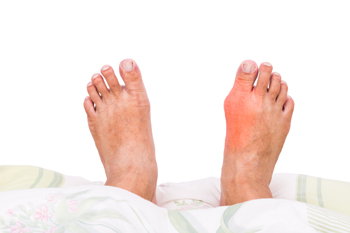 Have you noticed a bump appear on the side of your big toe? If so, you may have developed a bunion. Bunions can be common among older women, however, they can affect anyone. Those affected by a bunion may experience pain, swelling, difficulty walking, a callus on or around the bunion, and a misshapen toe that leans inward, caused by the bunion. Symptoms generally worsen over time if left untreated, which is why it’s important to seek immediate care. If you believe you are experiencing symptoms of a bunion, please consult with a podiatrist for a proper diagnosis and advised treatment plan.
Have you noticed a bump appear on the side of your big toe? If so, you may have developed a bunion. Bunions can be common among older women, however, they can affect anyone. Those affected by a bunion may experience pain, swelling, difficulty walking, a callus on or around the bunion, and a misshapen toe that leans inward, caused by the bunion. Symptoms generally worsen over time if left untreated, which is why it’s important to seek immediate care. If you believe you are experiencing symptoms of a bunion, please consult with a podiatrist for a proper diagnosis and advised treatment plan.
If you are suffering from bunions, contact Dr. Richard DiMario of Maine. Our doctor can provide the care you need to keep you pain-free and on your feet.
What Is a Bunion?
A bunion is formed of swollen tissue or an enlargement of boney growth, usually located at the base joint of the toe that connects to the foot. The swelling occurs due to the bones in the big toe shifting inward, which impacts the other toes of the foot. This causes the area around the base of the big toe to become inflamed and painful.
Why Do Bunions Form?
Genetics – Susceptibility to bunions are often hereditary
Stress on the feet – Poorly fitted and uncomfortable footwear that places stress on feet, such as heels, can worsen existing bunions
How Are Bunions Diagnosed?
Doctors often perform two tests – blood tests and x-rays – when trying to diagnose bunions, especially in the early stages of development. Blood tests help determine if the foot pain is being caused by something else, such as arthritis, while x-rays provide a clear picture of your bone structure to your doctor.
How Are Bunions Treated?
If you have any questions, please feel free to contact our office located in York, ME . We offer the newest diagnostic and treatment technologies for all your foot care needs.